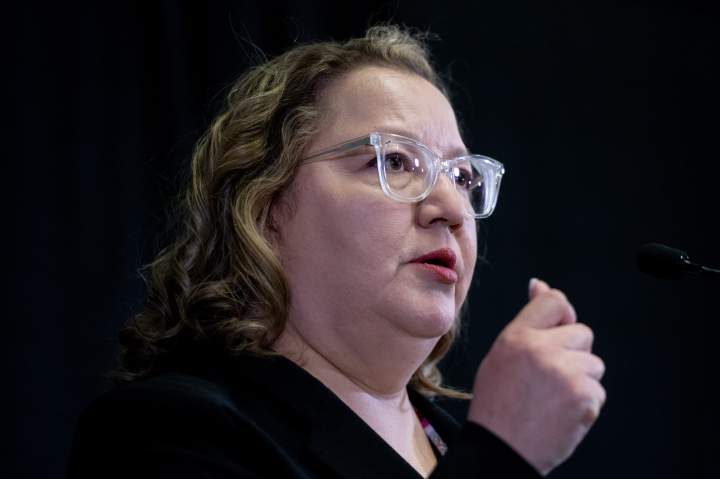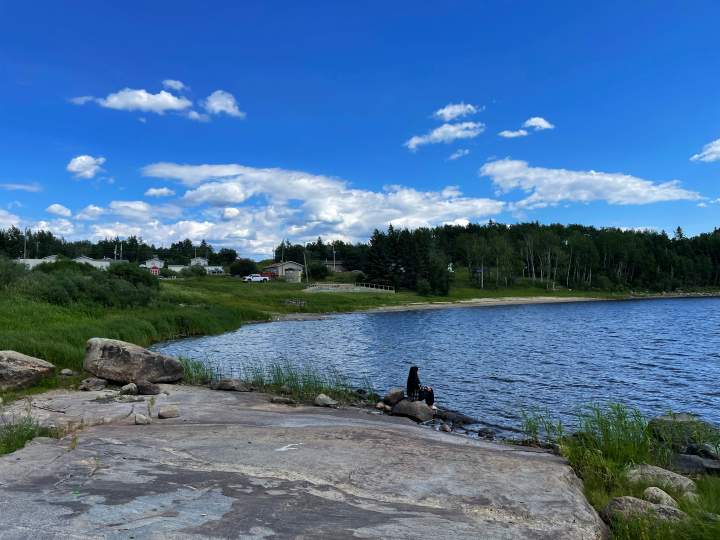
By
Carolyn Jarvis & Michael Wrobel
Global News
Published March 8, 2023
10 min read

Ethan Pokno’s knee shakes nervously as he recalls the moment he says his whole life flashed before him.
He was 12 years old. He and his three younger brothers were sent to foster homes and — for Ethan and the second-oldest brother — ultimately a group home a 10-hour drive away.
“Still scars me to this day,” he says.
There, Ethan says, he experienced violence, trauma and racism.
And any connection to his Indigenous roots was severed.
“You weren’t allowed to talk in your tongue. Staff would get mad, send you to your room, restrain you,” says Ethan, whose father and stepfather are both from Batchewana First Nation.
Indigenous kids and youth are vastly overrepresented in Ontario’s child-welfare system and often leave it more traumatized than when they entered it.
Mainstream children’s aid societies sometimes place kids wherever a “bed” is available — and that can be hundreds of kilometres away from a child’s community and culture. Until recently, babies were apprehended at birth, right from the hospital.
But an Indigenous organization called Nogdawindamin Family and Community Services has put a stop to that and has radically changed what child welfare looks like for their communities.
At the helm, CEO Kerry Francis.
“Our youth deserve to have a home instead of being shipped out down south and sitting in institutions,” Francis says.
Nogdawindamin petitioned the provincial government to take over child protection services for seven First Nations along the north shore of Lake Huron and — in 2017 — won.
Its first order of business: to bring their children home.
Ethan had been living at a group home in eastern Ontario for two years, a place he was initially told he’d only be for a couple of months.
But disappointment became a bedfellow.
He says he couldn’t even see his brother when he asked. The two were placed in separate buildings and could only visit during designated outside time.
The more his requests to return home went unanswered, the angrier he became — hardened by sorrow and loneliness.
“I thought I was never going to come back.”
The day Ethan learned Nogdawindamin had taken over his case is etched in his mind.
“I remember that day perfectly clear,” he says, a slight grin crossing his face. “Almost like I was getting out of a prison.”
On the long drive back to Sault Ste. Marie, Ethan and his brother sat in the car’s back seat and turned to each other. “We both said, ‘It’s over. We don’t gotta worry about it anymore.’”
In the years that followed, Nogdawindamin grew with incredible urgency — from 115 staff in 2017 to 380 today.
The leaders of the First Nations met with Francis and were clear about what had to be done. He had to build something new, “something out of the box.”
Culture would be its foundation.
Children were to be raised in the community and provided services grounded in Anishnawbek values.
Immediately, kids who had been placed in group homes were returned to live with relatives or community members.
Ethan, then 15, was given a new home with his uncle.
Nogdawindamin developed an ethos based on a “circle of care” — a belief that a healthy child flows from a healthy family and a healthy community. The circle had to support all three simultaneously.
High-needs youth with developmental or behavioural challenges are now given therapy to help develop coping and social skills. Their caregivers are supported by parenting coaches.
Children are offered mental health services with a blend of western and traditional healers. Since 2018, nearly a thousand children have received such support.
Nogdawindamin provides mental health services to adults as well.
New moms struggling with substance abuse are given help at Nogdawindamin’s “neonatal hub” to prevent babies from being apprehended from the hospital. Workers there assist mothers with parenting skills, accessing addiction programs, and finding stable housing.
There are even volunteer “baby cuddlers” who provide infants exposed to drugs in the womb with skin-to-skin contact and give respite to their mothers.
“It’s all about children, youth and families here on the North Shore,” Francis says. “Everybody deserves wellness.”
Nestled among the towering pines of Batchewana First Nation is Nogdawindamin’s teaching lodge, snow camouflaging its white canvas roof, which sits low to the ground.
Inside the lodge, a gentle dusting of snow from an advancing cold front drifts through a square cut-out air vent in the canvas ceiling, falling onto a fire below.
A fire-keeper places tobacco and cedar in the flames as an offering to the Creator.
This lodge is sacred.
Families experiencing hardship come here to find wellness. Kids in care come here to find healing. There is no judgment here.
And it took the community coming together to create it.
When they built the lodge, Francis explains, men bent maple saplings to form the arches of the roof while women secured the branches with ties.
It is a “mother’s womb,” he says.
There are six lodges like this one across Nogdawindamin’s region, with plans for a seventh this spring.
These lodges are one piece in Nogdwadmin’s journey to help its people reconnect with their roots.
“I was never brought up with my culture. I was never raised on the reserve,” says Francis, who is from Wikwemikong Unceded Indian Reserve. He’s the son of a residential school survivor, though his mother never spoke of her time there.
“Nogdawindamin has helped me on that personal journey — and I’m saying personal and not professional because it’s really helped me to understand my identity, who I am as an Indigenous person.”
At Nogdawindamin’s core is a belief that a sense of identity and culture will strengthen individuals and families.
A key part of that is the restoration of their language, Anishinaabemowin.
But Nogdawindamin’s staff aren’t teaching from a textbook.
In a hotel conference room in Sudbury, they’re playing Jeopardy!
“Numbers for 500.”
Seventeen-year-old Chance Neil from Mississauga First Nation slaps the bell first.
Ding! “Wegnesh Na Niizh?” — “What is number two?”
Chance is one of more than 100 people who have gathered here at an Anishinaabemowin language conference hosted by Nogdawindamin.
In the next room, two 13-year-olds from Atikameksheng Anishnawbek First Nation are learning how to bead. The teenagers painstakingly thread each “manidoomenens” (bead) to make a red and black dress in honour of missing and murdered Indigenous women.
“In this time of truth and reconciliation, we are bringing our younger generation back to instil that strong sense of identity,” says Marlene Syrette, one of 39 people on Nogdawindamin’s cultural team.
“When you have a strong sense of identity, it creates pride in who you are.”
Despite all of Nogdawindamin’s efforts to restore culture and support families, the number of kids in care is growing.
It’s not what they wanted to see.
In 2017, the agency had 109 kids in care. Today, there are 274.
“Am I concerned about that? Yes. Is my team concerned about that? Yes, we’re very concerned,” Francis says.
“But I think it has a lot to do with the systemic issues that Indigenous people have been exposed to: Indian residential schools, day schools, the Sixties Scoop. We’re dealing with that right now.”
Also, the opioid crisis is eviscerating Northern Ontario. In the last three years, there have been more opioid-related emergency room visits in the North East health region, which includes Nogdawindamin’s communities, than anywhere else in the province.
Francis says that without his team’s prevention work, he believes the number of kids in care would be much higher.
“You can’t expect us to recover over five years from years and years and years of trauma and harm that’s been caused on Indigenous people.”
However, some see those numbers as a positive sign: a sign of trust.
People are coming to Nogdawindamin for help who may have been hesitant to reach out to a non-Indigenous child protection agency.
For a time, there was so much tension between the First Nations on the north shore and the local children’s aid society that one community, Mississauga First Nation, passed a band council resolution banning Algoma CAS from coming onto its territory.
Algoma CAS says that since then, it has worked hard to mend those relationships.
The greatest source of friction for Nogdawindamin today is one that many Indigenous organizations struggle with: the government.
It claims the province is underfunding Nogdawindamin by $18 million annually.
“Our funding shortfalls are phenomenal,” Francis says.
Under an agreement with the federal government, Ontario is supposed to pay for child welfare services on reserves and be reimbursed.
Last year, the province provided Nogdawindamin with $25 million in funding.
But Francis says that doesn’t come close to covering their “true child welfare costs.”
The federal government has stepped in to bridge the gap.
The Canadian Human Rights Tribunal ruled that Canada was discriminating against First Nations youth by underfunding on-reserve services, forcing Ottawa to contribute more.
And so, Nogdawindamin got another $30 million directly from Indigenous Services Canada.
But there’s no guarantee that federal money will keep flowing, leaving the agency in a precarious position.
“Ontario needs to wake up,” Francis says.
Ontario’s Ministry of Children, Community and Social Services says Nogdawindamin needs to work “within their allocated budget” and should “continue working with the federal government and other partners” for additional support.
The ministry also says it’s making adjustments to its funding model to be more equitable toward “Indigenous, remote and northern societies.”
But funding is only one challenge. Provincial legislation hems in their dreams.
“Those processes don’t work for us,” Francis says.
The answer, Nogdawindamin believes, is for the First Nations on Lake Huron’s north shore to create their own child protection laws.
In 2019, the federal government passed Bill C-92, which recognizes First Nations’ right to self-governance over child welfare.
Empowered, Nogdawindamin and the First Nations it represents are in the second year of a five-year plan to develop and implement their own laws.
“As far as I’m concerned, there’s a better way to provide child welfare services, ” Francis says.
Today, Ethan Pokno is 21. He fidgets with the few hairs on his goatee that show he’s a man — though in so many ways, he’s been robbed of the childhood that led him here.
He still has nightmares from his time at the group home in eastern Ontario and deep wells of anger that make him snap quickly.
Nogdawindamin has given him therapy, but the damage runs deep.
“I don’t try to process it. I just bottle it — try and stuff it as far down as I can.”
Ethan thought that once he turned 18 and “aged out of care,” he’d be on his own.
But he’s reconnected with Nogdawindamin as part of a program that helps youths who’ve transitioned out of the child-welfare system.
His support worker, Katilin Whitely, has created a plan with him listing goals for success in adulthood and has put in an application with the federal government to fund it. It was just approved.
“A cellphone plan, a bus pass so you can get to and from work,” itemizes Whitely.
He’ll need a housing subsidy. Dishes. Cutlery.
He’s four credits shy of his high school diploma. He needs internet access.
It’s been eight years since Ethan was dropped off at that group home, where he felt abandoned.
Today, he looks down at his new plan with Nogdawindamin and says something you don’t always hear from kids in care:
“They’ll stay with you as long as you need.”
—with files from Maggie Feldbloom
If you would like to share your experience working or living in the child-welfare system, please reach out to us in the form below.














Comments